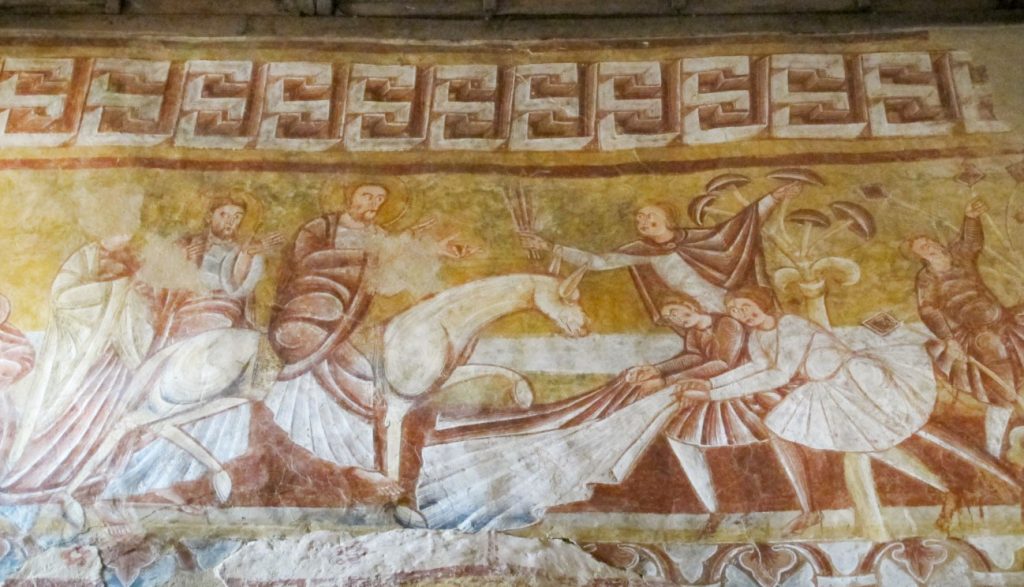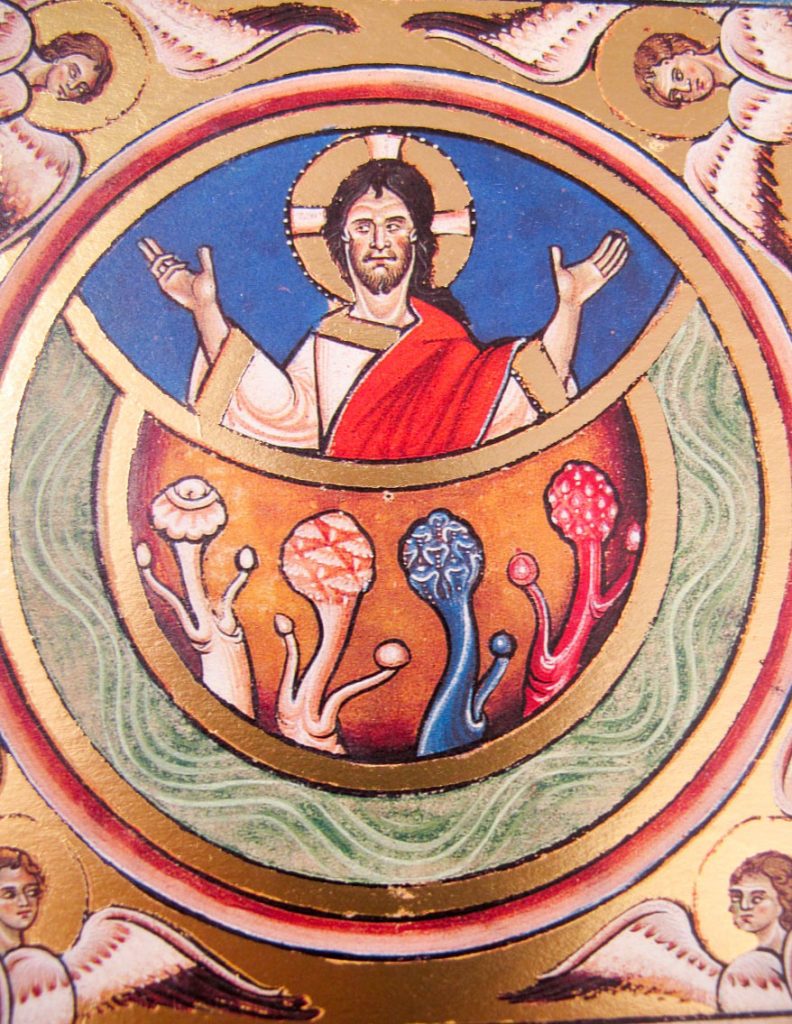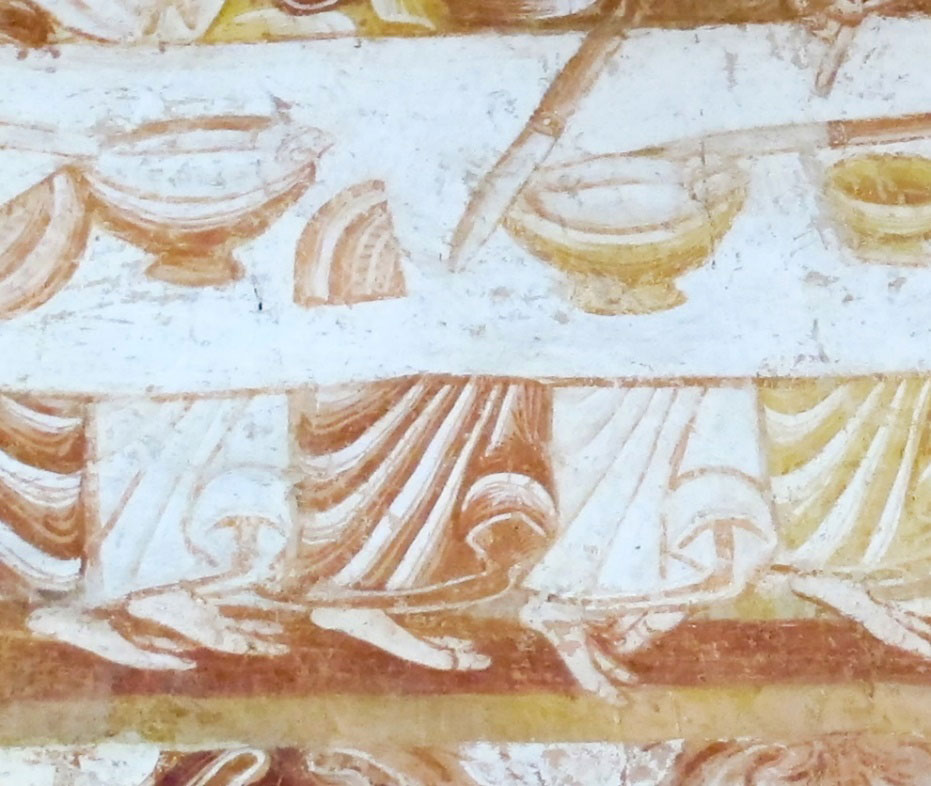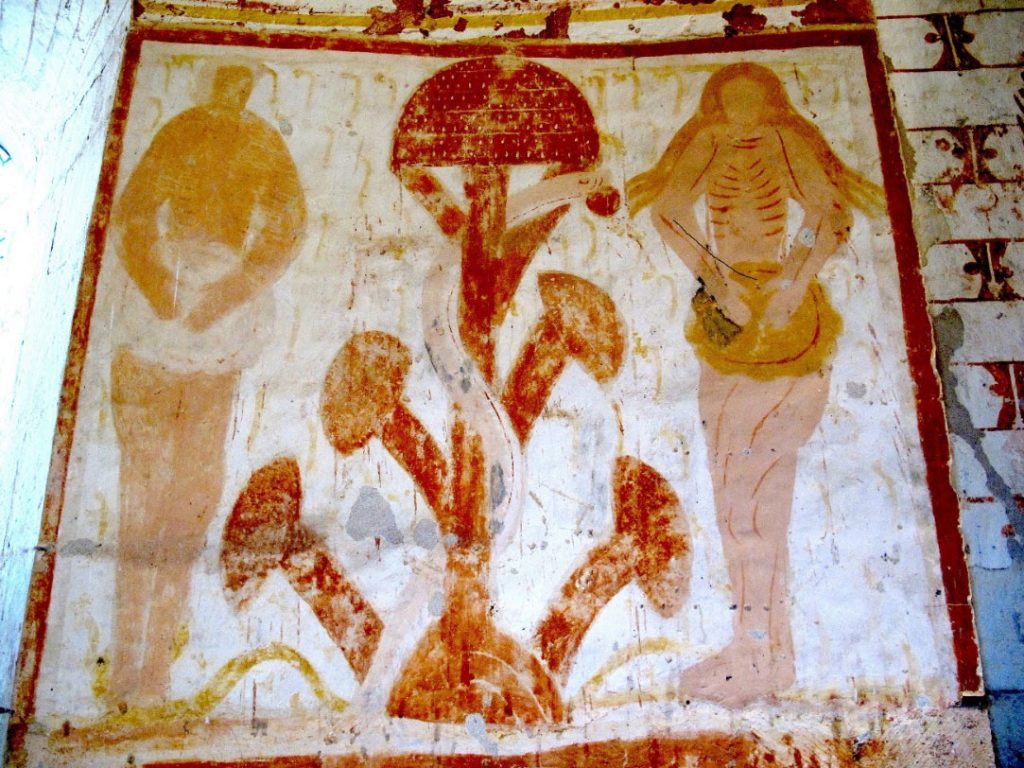It is our pleasure to welcome Julie and Jerry Brown, authors of The Psychedelic Gospels: The Secret History of Hallucinogens in Christianity, as our featured authors for November. Their book takes the reader on an anthropological journey throughout Europe and the Middle East. They provide compelling visual evidence that documents the role visionary plants have played in Christianity, challenging the reader to rethink what they think they know about the origins of Judeo-Christianity and the life of Jesus.
Interact with Jerry and Julie on our AoM Forum here.
There is an old saying: If you want to hide something, put it in plain sight. To our surprise, we learned that this saying is especially true for Christianity, where medieval works of art were created to illustrate the teachings of the Bible for the largely illiterate population. A close look at these religious artworks reveals the presence of psychedelic mushrooms–hidden in plain sight for centuries.
Based on stunning visual evidence of entheogens (plants that generate the divine within) found in cathedrals and churches throughout Europe and the Middle East, we propose the theory of the “Psychedelic Gospels.” By examining the Bible and the Gnostic Gospels through the lens of the Psychedelic Gospels, we reveal the role played by visionary plants in the origins of Christianity.
Astrophysicist Carl Sagan argues that “extraordinary claims require extraordinary evidence.” The remarkable photographs of entheogenic Amanita muscaria and Psilocybe mushroom images in Christian art, found in frescos, illuminated manuscripts, mosaics and stained-glass windows, provide this “extraordinary evidence.” Here are three examples from our book.
Entheogens in Christian Art
First, this fresco in the Church of Saint Martin de Vicq shows five large psilocybin mushroom caps spread out over the heads of the joyous youth greeting Christ as he enters Jerusalem (upper right-hand corner).

Photo: Julie M. Brown
Christ’s Entry into Jerusalem, Church of Saint Martin de Vicq, France
Fresco on south choir wall, early 12th century
Christ is moving towards the Towers of Jerusalem, depicted in an adjoining fresco which shows a youth using a long knife to cut through the stem of a giant psilocybin mushroom growing on top of the tower. A companion fresco depicts the famous Last Supper with a similar knife on the table along with what appear to be mushroom caps. Note that the artist has cleverly hidden a symmetrical row of mushrooms in the hems of the disciples!
Second, the twelve feet tall bronze Christ Column cast in 1015 by Bishop Bernard depicts the Transfiguration of Jesus, showing the disciples under a tri-fold psilocybin mushroom tree. This mushroom-tree is so realistically rendered in bas-relief that it has been identified as one of the most common European psilocybin mushrooms, Psilocybe semilanceata.
In the Transfiguration, the apostles Peter, James and John, go with Jesus to Mt. Tabor, where the Old Testament prophets Moses and Elias appear. There Jesus transforms before their eyes so that “his face did shine as the sun.” According to Matthew (17:5), “While he [Peter] yet spake, behold, a bright cloud overshadowed them: and behold a voice out of the cloud, which said, This is my beloved Son, in whom I am well pleased; hear ye him.”

Photo: Julie M. Brown
Scene 16, Transfiguration of Jesus, Christ Column, 1020
Saint Michael’s Church, Hildesheim, Germany
Bernward’s portrayal of the sacred mushroom-tree in the Transfiguration of Jesus is of particular significance. Unlike other miracles, which were performed by Jesus, this one happens to Jesus, reaffirming, as did the baptism by John, his divinely chosen role as the “Son of God.” The Transfiguration is the pivotal moment of the New Testament where humanity first intersects with God. As Bernward implies artistically, access to the divine is mediated through the sacred sacrament of psychoactive mushrooms.
It is worth noting that in most cases we do not know who placed these mushroom images in Christian art: the artist, the church fathers who commissioned the artist, or the church patrons who funded the frescoes? Or all three collaborating? However, in the case of the Christ Column, we know it was cast by the eminent Bishop Bernward, who was named a saint of the Catholic Church in 1193, some 150 years after his death.
God Creates Psychedelic Mushrooms
Third, the cover image of our book comes from the Great Canterbury Psalter, an illuminated prayer book that originated in the scriptorium of Canterbury Cathedral in England around 1180. The Psalter begins with eight stunning folios, each containing twelve lavishly colored, gold-embellished miniature paintings. These opening folios depict the history of the world according to Scripture, from Genesis to the life of Jesus. While the biblical narrative is traditional, offering psalms, songs and prayers, the illustrations are remarkable.

Courtesy of the Bibliotèque nationale de France
God Creates Plants, Great Canterbury Psalter, folio 1, England, 1180
Numerous red, blue, orange, and tan stylized mushrooms dot the first 100 pages, including this image showing God as the Creator of Plants; or, more specifically, as Creator of Sacred Plants. The red mushroom on the right with white speckles is Amanita muscaria. The next to appear is blue, attesting to Psilocybe mushrooms. While several authors have identified the following plant as a Syrian Rue (Peganum harmala) pod, careful inspection reveals that it bears no resemblance. Rather the color, shape, and fringes of the eight tiny mushroom images embedded in the cap suggest Panaeolus, a psilocybin-containing mushroom found in England and northern Europe. While others have described the plant on the far left as “an Opium Poppy in the shape of a mushroom,” again, there is little resemblance either to the flower or the pod of the opium plant. Instead, this appears to be another mushroom of the genus Psilocybe.
The presence of psychedelic mushroom images in the high holy places of England (Canterbury Cathedral), France (Chartres Cathedral) and Germany (St. Michael’s Church) suggest that the use of entheogens was widespread among the Catholic religious elite during the Middle Ages. This dispels the claim, made by author Brian Muraresku in The Immortality Key, that psychedelics had been systematically suppressed by religious authorities from the fourth century on, stamped out “beneath the jackboots of the Roman Catholic Church.” This argument is presented in Jerry B. Brown’s Review of The Immortality Key, found here.
Wasson-Allegro Controversy
The controversy between ethnomycologist R. Gordon Wasson (1898–1986) and philologist John Marco Allegro (1923–1988) over psychoactive mushrooms in Christianity in general, and over the identification of an A. muscaria mushroom (commonly known as “fly agaric”) in the 12th century Chapel of Plaincourault in Central France in specific, has cast a long shadow over the study of entheogens in Christian art – a shadow that has, as anthropologist Michael Winkelman points out, shaped “the academic response to Allegro’s book and the opinions of subsequent generations of scholars.”
The significance of the identification of the mushroom tree in Plaincourault as a psychoactive mushroom is a landmark in psychedelic studies of religion because it was the catalyst for the seminal debate between Wasson and Allegro about the role of entheogens in Christianity. If Wasson were right, then entheogens, especially sacred mushrooms, were only found at the early stages of Judeo-Christianity ending around the time of Genesis, well before 1000 BCE. However, if Allegro were right, then entheogens were integral to the origins of Judeo-Christianity with their usage persisting at least into medieval times, as evidenced by the Plaincourault fresco painted after 1000 CE. This positive identification of entheogens in Christian art would open the door to a line of inquiry that could ultimately require a reconsideration of the history of Christianity.
Many knowledgeable observers have interpreted this image as a mushroom or mushroom tree. Writing around 1900, Abbot Rignoux describes this fresco as a “mushroom-tree with several heads.” Soon afterwards, a photograph of this fresco was shown at a meeting of the Société Mycologique de France on October 6, 1910. The gentleman who presented the fresco made what was then the sensational observation that “instead of the customary Tree, the artist had given us the fly-agaric.” More recently, the official guidebook of “Mérigny-Indre, Chapelle de Plaincourault” makes note of the “tree of original sin depicted as an enormous mushroom.”
American ethnobotanist Richard Evans Schultes and Swiss pharmacologist Albert Hofmann comment that “The Tree of Knowledge, entwined by a serpent, bears an uncanny resemblance to the Amanita muscaria mushroom.” The Italian ethnobotanist Giorgio Samorini analyzed multiple representations of mushroom trees. He identifies Plaincourault as a prototypical A. muscaria mushroom-tree and contends that “Wasson’s conclusion may be considered premature.”
In a chapter titled “The Pope’s Banker,” we resolve Wasson’s greatest paradox: why did this indefatigable sacred mushroom seeker refuse to pursue his theory of the entheogenic origins of religion past the portals of the Church?
Our Differences with Allegro
While we applaud Allegro for being one of the first researchers to call attention to the seminal role of entheogens in religion, our theory differs from Allegro’s in three fundamental ways. First, while Allegro denies the existence of Jesus, we agree with religious scholars who believe that Jesus was an historical figure. Second, while Allegro bases his theory on the speculative interpretation of ancient languages, we base our theory on the plausible identification of entheogenic images. Third, while Allegro hopes that his writings will liberate people from the thrall of a false Christian orthodoxy, we hope that our discoveries will educate people about the history of psychoactive sacraments in Christianity.
“It’s The Da Vinci Code”
Calling our book “a mind-altering travelogue,” author Don Lattin describes it as “The Da Vinci Code meets The Electric Kool-Aid Acid Test.” The Psychedelic Gospels takes you along, step-by-step, on our decade-long anthropological adventure. It traces the tracks of sacred mushrooms across diverse ancient traditions, including the hymns of the Rigveda in India, the Eleusinian Mysteries of Ancient Greece, the healing cults of the Mazatec in Mexico, and the reindeer herders of the boreal forests of Siberia. Our quest begins with a surprising discovery of a psychoactive Amanita muscaria mushroom in Rosslyn Chapel in Scotland, and unfolds from the cathedrals at Canterbury and Chartres, to churches and chapels in France and Germany, to the magnificent museums of the Vatican in Italy, to remote cave churches of Turkey, and ultimately to the secluded pyramid chambers of pharaonic Egypt.
While our findings are startling, it is not our intention to question the fundamental beliefs of Christianity, but to uncover a mystery that we believe applies to many religions. Our findings do not deny the importance of religious sacraments but suggest that they should encompass all of God’s creations, including psychoactive plants. As Catholic Brother David Steindl-Rast perceptively asks, “If we can encounter God through a sunrise seen from a mountain top, why not through a mushroom prayerfully ingested?”
The presence of psychoactive plants in Judeo-Christianity, in ancient shamanism, and in the classical cultures of Greece and India raises intriguing questions about their broader role in the development of consciousness and culture. Did visionary plants play a seminal co-evolutionary role in the expansion of the human mind, as proposed in Terence McKenna’s Stoned-Ape Theory of human evolution? Is the “War on Drugs” the continuation of an age-old crusade by political and religious elites to control the public? Is the current resurgence of scientific research on the medical and therapeutic benefits of entheogens a tipping point that will lead to the end of this destructive war and possibly to a quantum leap in global consciousness?
Since biblical times, the sacred use of psychedelics has posed daunting challenges to religious and political communities. Challenges so great that with the coming of monotheism entheogens were suppressed as the forbidden fruit in the Garden of Eden in Genesis; demonized as the tools of satanic witches during the Inquisition; and banned as dangerous drugs in the 1970s. With the resurgence of interest in psychedelics, these challenges will surely resurface, as issues of medicine, religious freedom, and public policy.
Hopefully, this time around, we will address these concerns with an open heart and an open mind.
For additional information, see: “Entheogens in Christian Art: Wasson Allegro and the Psychedelic Gospels” and “Book Review of The Immortality Key,” in the Journal of Psychedelic Studies; and a 30-minute video presentation on The Psychedelic Gospels, Breaking Convention 2019, London. For our website, see: www.psychedelicgospels.com.










Enjoyed every moment learning through your knowledge of psychedelics in art and Christianity. Terrific presentation.
I don’t think Dr. Brown’s research stands the test of scrutiny – https://www.cannabisculture.com/content/2021/08/05/__trashed/
“American ethnobotanist Richard Evans Schultes and Swiss pharmacologist Albert Hofmann comment that “The Tree of Knowledge, entwined by a serpent, bears an uncanny resemblance to the Amanita muscaria mushroom.””
I would like to submit the following information for your consideration:
1) During the Old Kingdom, some royal women like Khufu’s mother Hetepheres I, and his granddaughter carried the title of ḫrp sšmt šnḏt, the Director of the Butchery of the Acacia House.
2) There is feline deity called Mafdet, attested as early as the First Dynasty guarding the Mansion of Life (https://www.wikiwand.com/en/Mafdet). This facility was a dining hall in the royal palace. The later House of Life attested since the Fifth Dynasty was the ancient Egyptian term for library.
3) The oldest religious texts in the world as yet known, the Pyramid Texts of Unas, mention how Mafdet slays the Underworld demon Apep (https://www.worldhistory.org/img/c/p/1200×627/4941.jpg). Apep is the snake that threatens the final phase of resurrection during which the spell-equipped spirits of the celestial bodies and the deceased royals must use Heka Magic in order to overcome these threats and to pass through the barriers between Earth and Sky. This final act of defeating mortality, i.e. the ultimate act of using divine knowledge to beat death, happens in the shade of the Acacia. Look how it is depicted looking like a mushroom. Nevertheless it was one of Africa’s most important trees.
4) Embedded within the word Mafdet is the word afdet, the ancient Egyptian word for portable archive, as in Ark, as in the biblical Ark of the Testimony. The afdet is attested from the First Dynasty. In the Coffin Texts of the Middle Kingdom it appears in the Book of Two Ways where it stores the words of creation from which the Sun God forges the universe. In other words, the afdet is the Egyptian version of the Ark of the Testimony housing the Logos of Genesis. This divine knowledge therefore is metaphorically encoded as a cat with a butcher knife slaying the demon snake under the Acacia Tree.
5) In summary: The Tree of Knowledge in its earliest known, textually attested form was an Acacia Tree, deified by the goddess Iws-aha-set. The divine knowledge was symbolized by a predator feline. The oldest known feline to guard a scribal facility known in the history of the world was the lioness Mehit attested from at least Narmer’s time. The lioness Mehit can be seen in one sealing dated to the First Dynasty guarding an administrative tent and under it is a gigantic snake with two heads.
6) Mehit, as I, together with my co-authors Robert Schoch and Robert Bauval, have shown was a monumental stony lioness located where now rests the Great Sphinx: In Giza.
7) To close, what about etheogens in ancient Egypt? This, too can be gleaned from the Pyramid Texts, specifically from the east gable inscriptions of the ante-chamber of Unas’ pyramid where a brew made from wine, grain, and the lily (“Egyptian lotus”) is insinuated and this cryptographically coded entry is complemented by the gable on the opposite side on the west wall, where the god Nefertem of the Lotus is mentioned by name. Cryptography in ancient Egypt is well documented with standard orthography and cryptography written side-by-side as seen in New Kingdom royal monuments and tombs for example.
There is a section on “Entheogenic Egypt” on pages 209-211 in our book, supported by color plates 27, Funerary stele of Lady Taperet and Horus, 850-690 BCE, and 28, Man confronting hyena with blue Amanitas, 1400 BCE. That said, the role of entheogens in Ancient Egypt merits its own book.
It makes perfect sense to think that Christianity has tasted psychoactive substances. As well as understanding why the relationship with plants and psychoactive substances was banned from Christian narratives and cosmo-theologies. Most likely, recognizing that the experience of the encounter with the spiritual world was provided by substances from “natural” beings, plants, mushrooms or animals, would fatally and threateningly relativize the conception and the mdiatiation of an omnipotent and omnipresent god, or a supernatural being.
Actually, our research stands up very well under scrutiny, as demonstrated in this video of “The Great Holy Mushroom Debate,” between me and critic Tom Hatsis at Breaking Convention 2019 in London. In this debate, I expose Hatsis’ egregious misrepresentation of our work as “disciples of Allegro.” One does not have to accept Allegro’s discredited theory that Jesus did not exist but was merely a mushroom metaphor in order to acknowledge the presence of psychoactive mushrooms in early and medieval Christian history. For debate video, see: https://youtu.be/ZIUmR7o6RGg
Entheogenic Egypt – Pages 209-211 in The Psychdelic Gospels discuss entheogens in Ancient Egypt, and color plates 21 and 22 show datura and rare blue Amanita muscaria images in Egyptian art from Thebes. Obviously, there is so much more including in the Book of the Dead, whose literal title is is translated as Book of Coming Forth by Day or Book of Emerging Forth into the Light. We tried to travel to Egypt twice from Turkey duing our 2012 research journey, but were dissuaded due to the instability surrounding the Arab Spring uprisings.
Amazing I’m writing a book about my transformation into an artist I’m including psychedelics? the history of our planet Holistic healing with numerous modalities graham is mentioned as teacher 11 the book is called the 6th Son
Great stuff guys. I think and feel there is a need (& lotsa mush room) in our journey here on Earth to probe the many levels of consciousness available to us. Many of us have had our innate spiritual consciousness bloom thru the use of plants, some confirming the beliefs that we are eternal souls dwelling in a super bio-computer avatar, called the temple of the body. Mind boggling indeed.
Please continue your spirited journeys and discussions, as you have in many other parallel lives both past and future. Only you can know you. We have been thru this before, but rarely in the light of day.
If someone else says my thoughts we must be on the rightish path.non no for sure one theory today is sltererd tomorrow chris.no one can proove anything until what they are implying,the only way to do that is in Hallucination.
All civilisations b4 us have worked out something and acted on it.we on the other hand in scfi age deny to immerse ourselfs into it.
5 dried grams in the silent darkness surrounded by stone.
They love a chat especially if you dont go wow
I had the pleasure of listening to “The Immortality Key” by Brian C Maurauesku which discusses the same topic. I shall be sure to get this book also. Thanks for the Article.
My book review of The Immortality Key concludes: TIK will entice general readers but exasperate academics, even those who may agree with its specific conclusions regarding the role of entheogens in the Eleusinian Mysteries or early Christianity. Despite its popular appeal as a New York Times Bestseller, TIK fails to make a compelling case for its grand theory of the “pagan continuity hypothesis with a psychedelic twist” due to recurring overreach and historical distortion, failure to consider relevant research on shamanism and Christianity, and presentation of speculation as fact.” For full Book Review, see: https://akjournals.com/view/journals/2054/5/1/article-p5.xml?rskey=FocHfx&result=1
I wonder how long it will take for it to get on the “New York Times Best Seller” list?
Hopefully not as long as the 300 years it took the Catholic Church to apologize to Galileo.
“Roughly 35 miles south of Jerusalem, in an archaeological site in the Negev desert known as Tel Arad, archaeologists excavating an ancient Jewish shrine have found traces of burnt cannabis and frankincense on a pair of limestone altars, reports Kristen Rogers of CNN.”
https://www.smithsonianmag.com/smart-news/cannabis-found-altar-ancient-israeli-shrine-180975016/
On archaeological chemistry: in my book review of The Immortality Key, I summarize the book’s most significant finding – for full review, see: https://akjournals.com/view/journals/2054/5/1/article-p5.xml?rskey=7B27un&result=1
“Pouring through relevant archaeological studies of the 2000s, including publications in Catalan, Muraresku came across the name of Jordi Juan-Tresserras, an archaeobotantist from the University of Barcelona. Muraresku reports that, in a brief paragraph buried in an article in a peer-review Spanish journal, Juan-Tresserras mentions the “apparently unremarkable discovery” of “‘the remains of ergot sclerotia’ at Mas Castellar de Pontós in not one, but two different artifacts connected to Pons’s iconic ‘domestic chapel’.” The chemical signatures of the fungi were found in the remains of teeth embedded in a human jawbone and in a “miniature chalice,” a tiny cup similar to the kernos in which the kykeon was served to initiates in the telesterion, the inner sanctuary at Eleusis.
“In a heartwarming scene, Muraresku describes how he invites the “old professor” Ruck to accompany him on a visit with Pons in Catalonia for a tour of the Museu de Arqueologia de Catalunya-Giron, home to artifacts from Mas Castellar de Pontós. Specifically, Muraresku’s revelations afford Ruck the satisfaction, albeit belatedly, of seeing the conclusions of The Road to Eleusis scientifically validated through archaeochemistry whose analytic technologies were not available four decades ago when the book was first published.”
1. In forefront of the cars forth goes the Hero, the Leader, winning spoil: his host rejoices.
Soma embues his robes of lasting colours, and blesses, for his friends, their calls on Indra.
2. Men decked with gold adorn his golden tendril, incessantly with steed-impelling homage.
The Friend of Indra mounts his car well-knowing, he comes thereon to meet the prayer we offer.
3. O God, for service of the Gods flow onward, for food sublime, as Indra’s drink, O Soma.
Making the floods, bedewing earth and heaven, come from the vast, comfort us while we cleanse thee
4. Flow for prosperity and constant Vigour, flow on for happiness and high perfection.
This is the wish of these friends assembled: this is my wish, O Soma Pavamana.
5. Father of holy hymns, Soma flows onward the Father of the earth, Father of heaven:
Father of Agni, Surya’s generator, the Father who begat Indra and Visnu.
6. Brahman of Gods, the Leader of the poets, Rishi of sages, Bull of savage creatures,
Falcon amid the vultures, Axe of forests, over the cleansing sieve goes Soma singing.
7. He, Soma Pavamana, like a river, hath stirred the wave of voice, our songs and praises.
Beholding these inferior powers in cattle, he rests among them as a Steer well-knowing.
8. As Gladdener, Warrior never harmed in battle, with thousand genial streams, pour strength and vigour.
As thoughtful Pavamana, urge O Indu, speeding the kine, the plant’s wave on to Indra.
9. Dear, grateful to the Gods, on to the beaker moves Soma, sweet to Indra, to delight him.
With hundred powers, with thousand currents, Indu, like a strong car-horse, goes to the assembly.
10. Born in old time as finder-out of treasures, drained with the stone, decking himself in waters,
Warding off curses, King of all existence, he shall find way for prayer the while they cleanse him.
11. For our sage fathers, Soma Pavamana, of old performed, by thee, their sacred duties.
Fighting unvanquished, open the enclosures: enrich us with large gifts of steeds and heroes.
12. As thou didst flow for Manu Life-bestowing, Foe-queller, Comforter, rich in oblations,
Even thus flow onward now conferring riches: combine with Indra, and bring forth thy weapons.
13. Flow onward, Soma, rich in sweets and holy,. enrobed in waters on the fleecy summit.
Settle in vessels that are full of fatness, as cheering and most gladdening drink for Indra.
14. Pour, hundred-streamed, winner of thousands, mighty at the Gods’ banquet, Pour the rain of heaven,
While thou with rivers roarest in the beaker, and blent with milk prolongest our existence.
15. Purified with our holy hymns, this Soma overtakes malignities like some strong charger,
Like fresh milk poured by Aditi, like passage in ample room, or like a docile car-horse.
16. Cleansed by the pressers, armed with noble weapons, stream to us the fair secret name thou bearest.
Pour booty, like a horse, for love of glory God, Soma, send us kine, and send us Vayu.
17. They deck him at his birth, the lovely Infant, the Maruts with their troop adorn the Car-horse.
By songs a Poet and a Sage by wisdom, Soma goes singing through the cleansing filter.
18. Light-winner, Rishi-minded, Rishi-maker, hymned in a thousand hymns, Leader of sages,
A Steer who strives to gain his third form, Soma is, like Viraj, resplendent as a Singer.
19. Hawk seated in the bowls, Bird wide-extended, the Banner seeking kine and wielding weapons,
Following close the sea, the wave of waters, the great Bull tells his fourth form and declares it.
20. Like a fair youth who decorates his body, a courser rushing to the gain of riches,
A steer to herds, so, flowing to the pitcher, he with a roar hath passed into the beakers.
21. Flow on with might as Pavamana, Indu flow loudly roaring through the fleecy filter.
Enter the beakers sporting, as they cleanse thee, and let thy gladdening juice make Indra joyful.
22. His streams have been effused in all their fulness, and he hath entered, balmed with milk, the goblets.
Singing his psalm, well-skilled in song, a Chanter, he comes to his friend’s sister roaring.
23. Chasing our foes thou comest, Pavamana Indu, besting, as lover to his darling.
As a bird flies and settles in the forest, thus Soma settles, purified, in goblets.
24. With full stream and abundant milk, O Soma, thy beams come, like a woman, as they cleanse thee.
He, gold-hued, rich in boons, brought to the waters, hath roared within the goblet of the pious.
– Rig Veda, 9th Mandala, Hymn 96
“Heaven does not equal half of me – have I been drinking Soma”
“I will pick up the earth and put it here or there – have I been drinking Soma?
“the pillar of heaven”
“the God for Gods|
The iconic mosaic at hagia sophia appears to show little brown mushrooms on jesus and mary’s cushion, as i observe. 4 little spade shapes on viewer’s left, one on the right. Am i trippin?
If you have one, please post link to photo of the scene you describe.
What an extraordinary amount of research and already I am fascinated. I would love to get a copy of the book and share this review on my website http://www.lifeinbalance.co.z. May I have your permission to do so?
Hi Melissa – delighted to have you share this review on your website. Also please consider posting an Amazon Customer Review. Best wishes, Jerry B. Brown
Thanks so much Jerry – it is live here https://lifeinbalance.co.za/2022/01/07/november-2021-aom-the-psychedelic-gospels-the-secret-history-of-hallucinogens-in-christianity/
What an interesting study into the hidden culture built within the Christian faith and community. Psychedelic mushrooms are not the limit within the Christian Church. Emanuel Swedenborg, philosopher and scientist(late 1600’s) Used Opium to get closer to God. I have always discredited Swedenborg for the use of opium when writing, but maybe this is the key to enlightenment, after all. I would be interested in further readings on the topic.